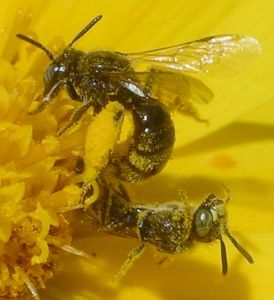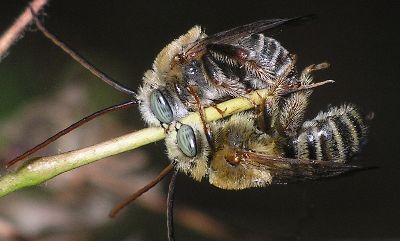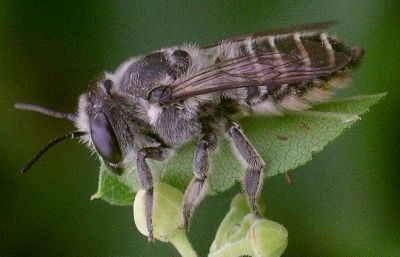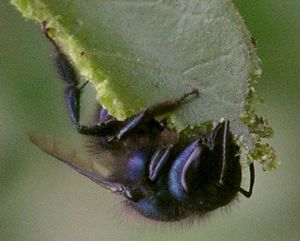
A second male trying to dislodge a mating male
(megachilidae: Anthidiellum notatum)
 A second male trying to dislodge a mating male (megachilidae: Anthidiellum notatum) |
Even in a spot where one can watch insects closely, such as a particularly attractive flower patch, it might be hard
 A mated pair (andrenidae: Protandrena sp.) |
Beyond the bee basics, this is a fascinating group of insects to observe. Bees evolved from one family of wasps and, just as butterflies are mostly easy to tell from moths, so it is not too hard to figure out bees from their relatives.
 Male digger bees sleeping (apidae: Melissodes sp.) |
Several methods of pollen collection are used by different kinds of bees and with various types of blooms. Most flowers have pollen exposed on stamens, and the bees need only rub their hairs against the grains to get them to stick. Other blossoms have pollen in tubes, and it must be shaken out through a process called buzz-pollinating, or sonication. The sound of the bee's buzz changes quite obviously when it is performing this action. Some bees, such as honey bees, push the pollen into sacs on their legs, while others have thick hairs that collect the pollen in a looser form. The pollen hairs on leaf-cutter bees, as I mentioned earlier,
 Eastern carpenter bee nectar stealing (apidae: Xylocopa virginica) |
The majority of bees seen around flowers are females. The workers in social colonies are all female and solitary females build and provision their own nests with no assistance from males. Males DO hang around flowers, though, mainly because that is the place to find the females. Large carpenter bee males hover threateningly (but don't worry - only female bees can sting) when anything enters their territory, and a few bees even mate right down amidst the flowers. This, however, is the exception, because mating for bees is a chaotic and competitive affair. Most bee couples fly high in the air or away from food sources so that they can copulate undisturbed by the numerous other males seeking to do the same. One kind of bee, in the family Andrenidae, remains in tandem as the female goes about foraging. This guarding behavior by the male means that the female is unlikely to mate with any subsequent suitors.
 Leaf-cutter bee with leaf bit (megachilidae: Megachile sp.) |
Bees have both sucking and chewing mouthparts. They sip nectar and usually use their jaws for nest construction. Leaf-cutter bees and carpenter bees are both well known for particularly strong jaws. Large carpenter bees dig out nest holes in wood. They pack pollen inside along with the egg that will hatch into a grub which then feeds on the stored food. Carpenter bees have rather short tongues and so have a hard time reaching nectar in flowers with deep throats. Their powerful jaws come in handy, though, for cutting through the base of the flower to get at nectar. Because the bee obtains a reward while not brushing against the stamens or pistil of the blossom, and thus without performing pollination, this method of feeding is called nectar-stealing.
 Mason bee collecting sumac leaf material to plug its nest (megachilidae: Osmia ribifloris) |
Leaf-cutter bees do not cut their signature circular holes in leaves for food. Instead, they use the pieces of leaves, and sometimes also flower petals, to line their nest, helping to waterproof it. It is quite difficult to see a leaf-cutter bee actually cutting a piece out of a leaf. They do it very quickly, and it looks sort of like somebody using scissors to quickly snip out a desired shape. In seconds, the leaf bit is severed, rolled up, and carried away in the bee's jaws and legs.
One curious behavior I just learned about is common among mason bees (Osmia ribifloris) in our area. These bees nibble the edges of leaves on evergreen sumac, making a paste that they use to create partitions and plugs in their nests (often renovated mud dauber nests). Some mason bees use mud but this species prefers leaf masticate.
With the current interest in native bees due to their importance for pollinating a large variety of plants, it doesn't hurt to learn more about their behaviors and habitat needs. Yes, bees can sting. But, no, I've never been stung by a bee I was watching. It's the ones that I do not notice that let me know when I've accidentally put my hand on them!